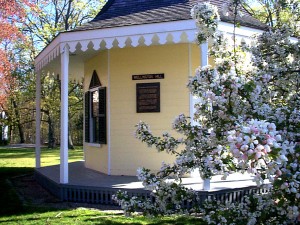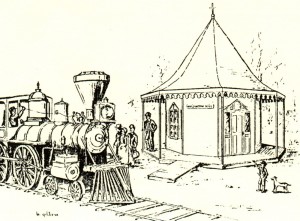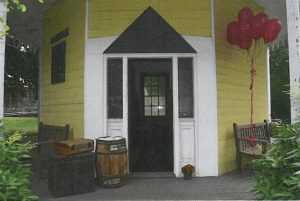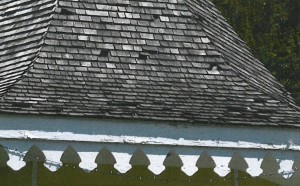Wellington Station
Preservation of Belmont’s Historic Wellington Station

Located on town-owned parkland at 2 Common Street (adjacent to the First Church in Belmont), the historic Wellington Station is a highly visible local landmark close to Belmont Center. This structure is the focal point of the banner at the top of each page of our website. The Belmont Historical Society has owned and maintained this 174-year-old building for the past 40 years. In 2015 the Society applied for and received a Community Preservation Act (CPA) grant to cover the cost of replacing the wooden roof of the station. In the Fall of 2016 the Society’s Board authorized funds to cover the cost of repairing the wooden porch and painted trim of the station. The major restoration work, including the replacement of the wooden roof shingles, was completed in October 2017.
Background

The Wellington Station was built in 1840 near its present location by Samuel O. Mead for use as a private school until 1851, when it was rented to the Fitchburg Railroad to replace the first train station that burned that year. In 1852 the building was sold to the railroad and moved to the present site of the Municipal Light Building where it served as a train station until being replaced by a larger structure in 1879. The station was moved to the Underwood Estate where it served as a summer house and artist’s studio until 1974 when it was given to the Belmont Historical Society and then moved to its present site in 1980.

Today the building is used for exhibits and is periodically opened to the public for special events such as Town Day and occasional open houses sponsored by the Society. The station is one of Belmont’s most visible and beloved historic resources. This small, octagonal building with a pointed roof is a rare Gothic Revival style structure in Belmont and is the centerpiece of the Common Street local historic district. It is also listed in the State Register of Historic Places and is eligible for listing on the National Register of Historic Places. This building is an important link to Belmont’s nineteenth century past and is an important feature that enhances the historic setting of this town-owned park.

The existing wood shingle roof (now almost 30 years old) is nearing the end of its useful life and needs to be replaced to prevent water damage to the interior structure. The Belmont Historical Society has been the responsible steward of the Wellington Station for nearly 40 years and has handled normal repair and maintenance work as necessary. However, period-authentic wood shingle roofs eventually deteriorate to the point that the only option is complete replacement. Consequently, the Society sought and received CPA funds from the Belmont Town Meeting to cover the cost of stripping the existing roof, repairing deteriorated roof sheathing boards, and installing a new wood shingle roof. The CPA-funded work was completed in 2017. Repairs to the porch that surrounds the station are being paid for by the Society, and that work began in October 2016 and is continuing through the winter of 2017. Click here to see some photographs of the work in progress.
Community Preservation Act
The Community Preservation Act (CPA) was adopted by Belmont voters on November 2, 2010, with the Act to begin funding in FY2012. The Act establishes a Community Preservation Fund financed by property tax surcharges and annual distributions received from the State “Massachusetts Community Preservation Trust Fund”. All funds are to be used to:
- Acquire, create and preserve open space
- Acquire, preserve, rehabilitate and restore historic resources
- Acquire, create, preserve, rehabilitate and restore land for recreation use
- Create, preserve and support community housing
- Rehabilitate and restore open space and community housing acquired or created using monies from the fund
This gives the community the opportunity to determine its priorities, plan for the future, and have the funds to make those plans happen. A Community Preservation Committee composed of local citizens reviews applications for specific projects and makes recommendations for the use of the funds. The final authority for approving CPA funds for specific projects rests with the Town Meeting. Click here for more information about the CPA process.
Historic preservation is clearly one of the objectives of the CPA process, and that is the category under which the Belmont Historical Society submitted the application for the repair of the Wellington Station.